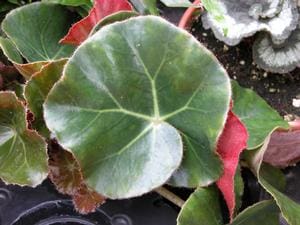Helpful tips for successfully growing Begonias
Begonias range in size from 2 inches in height to giants which may grow 12 feet in height. Growing these plants is not difficult, provded one observes their basil requirements.
LIGHT: Begonias need bright light but should be protected from the mid-day sun in some situations. Cane-like, Shrub-like, and Semperflorens begonias in many situations can actually handle stronger light, if acclimatized. Never move a plant from a house directly to full sun; it will burn it.
TEMPERATURE: Begonias grow best between 60 and 75 degrees F. They do enjoy some temperature difference between night and day.
MOISTURE: Water only when the medium begins to dry out. Plants that are overwatered may rot or drop leaves and blossoms.
HUMIDITY: Except for the Mexican hairy Begonias, most Begonias prefer extra humidity in the home. Place a tray filled with pebbles beneath the plants and fill the tray shallowly with water.
FERTILIZER: Give your begonias a mild solution of a complete fertilizer. You can use ¼ strength with every watering, however, if the plants are going into dormancy as some do in the fall, drop the feeding entirely.
PINCHING & PRUNING: Many begonias require regular pinching and pruning to encourage symmetrical growth. Pinching increases the number of shoots and encourages them to branch.
Begonia Categories
Cane-like Begonias
Often called Angel Wing Begonias, members of this group have long, straight, bare, jointed stems with swollen nodes. Flowers of this group hang in clusters with as many as 30 or more blossoms in a single cluster, ranging in colors from white to orange, salmon, pink, and reds. The leaves may be soft or leathery and have pink, red or silver splotches. Keep from drafts.
Shrub-like Begonias
These plants generally produce a number of stems from the ground and branch freely, producing the full appearance of a shrub. One subgroup has bare leaves while the other has hairy leaves.
Thick-stemmed Begonias
This group has thick tapering stems with no discernable joints or nodes. The stems may be brittle or woody.
Semperflorens Begonias
Also called wax-leaf begonias, these are familiar as outdoor bedding plants used frequently for ease of growth and constant bloom. They like partial to full sun, and adequate moisture. Many varieties come in green, bronze, or variegated foliage with white, pink, coral or red flowers. Pinch off the growing tips of young plants at two week intervals, two or three times, to produce always flowering, compact plants. Sometimes they can be grown successfully in the home over the winter, but unless good light is provided, they become spindly and weak.
Rhizomatous Begonias
These are characterized by a large fleshy stem that may grow at or below the soil surface or erect, from which the leaves and flowers arise. Many of the leaf patterns are very beautiful. Winter and early spring are the flowering time for the majority of rhizomatous types. These begonias adapt fairly well to the home environment with adequate (but not excessive) water, humidity and light.
Rex Begonias
Rexes have an infinite variety of leaf shapes and colors, and some of the foliage can be the most brilliant of all plants grown. The majority have a thick rhizome from which the leaves and flowers arise. Like the rhizomatous, rexes require adequate moisture, higher humidity, warmth and moderate light. They will often go dormant in the winter.
Tuberous and Semi-Tuberous Begonias
This group includes the well-known tuberhybrida and hiemalis (Rieger) types, and some interesting semi-tuberous varieties that are small compact plants. The Rieger types require cooler temperatures between 55 degrees F. and 65 degrees F. for continuous growth and flowering.
Trailing Scandent Begonias
Here we find flexible trailing stems from which leaves and flowers arise. They make handsome basket plants and can be used effectively in windows.
Terrarium Begonias
This is not a horticultural category, but the growing of begonias requiring much more humidity is becoming quite popular. These need to be grown in an enclosed container due to their humidity requirements. However, their need for light is much less and they can easily be grown with much less care than those requiring less humidity. It must be kept in mind that begonias in enclosed containers should not be exposed to direct light at all.
Hardy Begonias
A few Begonia varieties are quite hardy. Mulching in winter is recommended. They prefer shade and a very well-drained compost.

